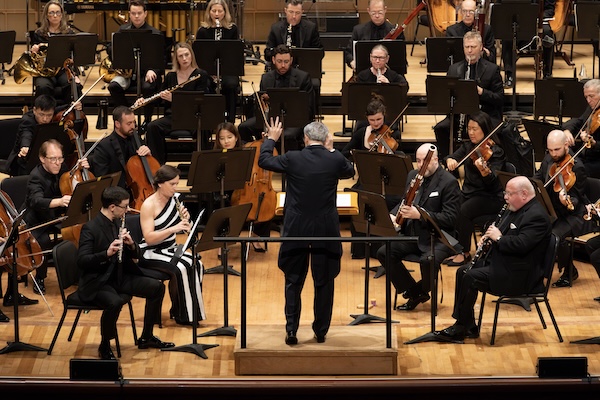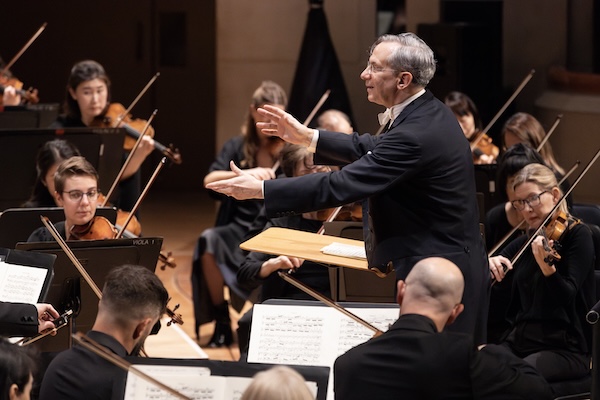Dallas Symphony winds take the spotlight in Shepherd concerto premiere

The world premiere of Sean Shepherd’s Concerto for Flute, Oboe, Clarinet and Bassoon was the main order of business Thursday night with Fabio Luisi leading the Dallas Symphony Orchestra.
The American composer is noted as an orchestral colorist and the prospect of a concerto featuring the four principal winds of the orchestra would seem to suggest far-reaching possibilities for this commission. Having worked with each of the DSO wind principals in the past, Shepherd described his piece as an opportunity to write for his “Woodwind Dream Team.”
His piece appears to be informed by the Baroque concerto grosso, contrasting the small group of soloists with the ripieno forces of the larger orchestra. The opening of the concerto seemed to confirm this—flutist David Buck led off the first of the concerto’s three movements with an energetic and angular melody that was taken up by oboist Erin Hannigan before being similarly appropriated by Ted Soluri’s bassoon and Gregory Raden’s clarinet.
Soon after the orchestra joined this small group, the nature of instrumental colors to be explored became apparent; the ensemble was augmented by a sizable array of metallic and wooden percussion instruments that carved out a distinct presence of their own within the orchestral texture. Having started rather briskly, the first movement saw the whole orchestra take up and relentlessly reiterate fragments of the opening melody, such that the abrupt end to the movement came as a jolt.
Soluri began the second movement with a brief solo for bassoon, but the orchestra soon initiated a texture busier and more chaotic than that of the first movement (the second movement’s subtitle is “Heavy Machinery”).
Unfortunately, throughout the first two movements, it was difficult to distinguish contributions by the soloists, largely because few of their parts included melodic lines long enough to stand out from the splintered texture of the larger ensemble and because the volume of the orchestra too often overshadowed the sound of the soloists.
The third movement, stemming from a rapid decrescendo ending the second, came as a welcome respite from the cacophony of the first two. This movement was slower and more atmospheric, with gestures and occasional harmonies evoking Debussy. The calmer texture allowed greater space for the soloists; indeed, one of the most striking moments of the third movement was a passage featuring the solo quartet sounding an extended rendition in unison of a long-breathed, lyrical melody that nonetheless possessed an angularity reminiscent of the opening of the first movement.
Shepherd’s concerto is striking in its use of orchestral color, but the soloists’ role in producing that color were not very clear. Moments when the soloists were trading or sharing material, such as the passages described above in the first and third movements, were the most engaging, making the relative inaudibility of some of the interactions more disappointing.
The program began with Adagio by Robert Xavier Rodríguez, a concise, lyrical and reflective piece that recalled the style of Aaron Copland. The opening oboe solo was quickly answered by a chorus of strings, starting off the piece with a pastoral character that was reinforced over its course by similar interplay between the strings and winds. This interplay with the winds, played here by the associate principals, nicely foreshadowed the concerto that was to follow.

The second half of the program consisted of Mendelssohn’s “Scottish” Symphony, rendered with the crisp and dynamic execution that audiences have come to expect from the DSO under Luisi. Inspired by Mendelssohn’s sojourn in Scotland in 1829, the symphony features a variety of moods—from the severity of the Scottish highlands to the briskness of Scottish dance to the stateliness of Holyrood Chapel.
All of these were brilliantly captured in performance by the Dallas Symphony Orchestra. Luisi’s fluid direction mirrored the delicate solemnity of the symphony’s introduction before shifting to the stately vigor of the first movement’s main theme. The scherzo, a boisterous movement marked by Scotch snap rhythms, followed as Luisi’s movements on the podium reflected the rollicking sounds issuing from the orchestra.
The slow movement brought a return to the solemnity of the introduction. Luisi deftly guided the orchestra in the movement’s variations of a lyrical melody sounded by strings and winds alternating with a more regal theme sounded by the full ensemble.
After a final recollection of the symphony’s introduction, Luisi launched the main body of the finale, which combined the bustling rhythms and activity of the scherzo movement with the serious mood of the first. The finale’s coda supplanted this vigorous motion with a majestic, hymn-like tune that functioned as an apotheosis for the symphony overall and made for a grand conclusion to the concert as a whole.
The program will be repeated 7:30 p.m. Friday and Saturday. dallassymphony.org